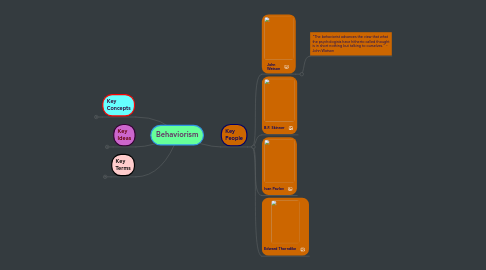
1. Key Concepts
1.1. Reinforcement
1.1.1. The purpose of resinforcement is to increase the likelihood of a response.
1.1.2. Two Types
1.1.2.1. Positive Reinforment (Something Added)
1.1.2.1.1. Example: If one studies and gets good grades, the likelihood of one studying again is higher.
1.1.2.2. Negative Reinforcement (Something Taken Away)
1.1.2.2.1. Example: If one studies and one's fear of failing disappears as a result, the likelihood of one studying again is higher.
1.2. Punishment
1.2.1. The purpose of punishment is to decrease the likelihood of a response.
1.2.2. Two Types
1.2.2.1. Positive Punishment (Something Added)
1.2.2.1.1. Example: If one studies and is called a "nerd" as a result, the likelihood of one studying again is lower.
1.2.2.2. Negative Punishment (Something Taken Away)
1.2.2.2.1. Example: If one studies and as a reults does not get to spend enough time with friends, the likelihood of one studying again is lower.
2. Key Ideas
2.1. The theory that human or animal psychology can be studied only through examination and analysis of observable behaviors.
2.2. A behaviorist would explain behavior through the force of nurture.
3. Key Terms
3.1. Systemic Desensitization
3.1.1. A step-by-step technique used to help one get rid of anxiety associated with phobias.
3.2. Modeling
3.2.1. A technique used to help one learn a desired response by making one imitate the behavior of a model.
3.3. Aversive Conditioning
3.3.1. A technique in which punishment and other harsh treatments are used to lower the occurence of a undesirable behavior or response.
3.4. Token Economy
3.4.1. A technique in which a person receives tokens (can be exchanged for rewards) for displaying good social and personal behavior.
3.5. Flooding
3.5.1. A desensitication technique in which a person is constantly faced with his or her biggest fear or anxiety-producing stimuli.
3.6. Shaping
3.6.1. A step-by-step technique that reinforces progessively closer approximations of the desired behavior.
4. Key People
4.1. John Watson
4.1.1. "The behaviorist advances the view that what the psychologists have hitherto called thought is in short nothing but talking to ourselves." - John Watson
